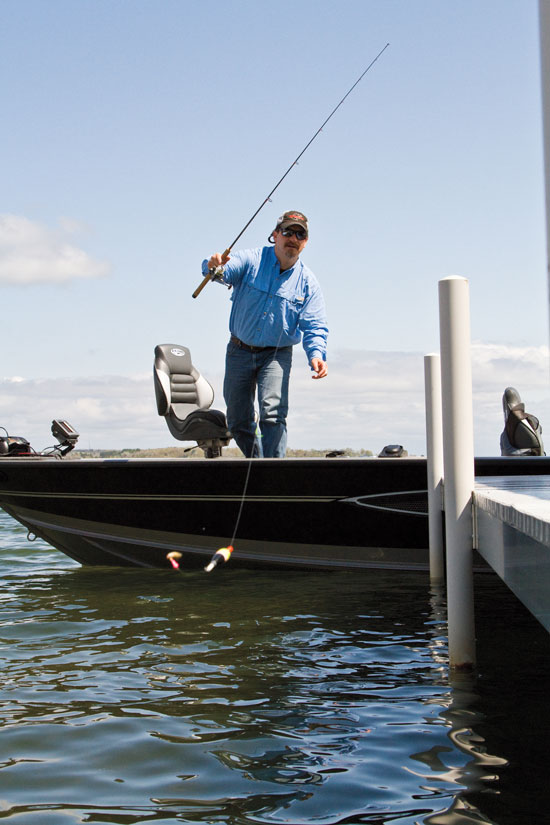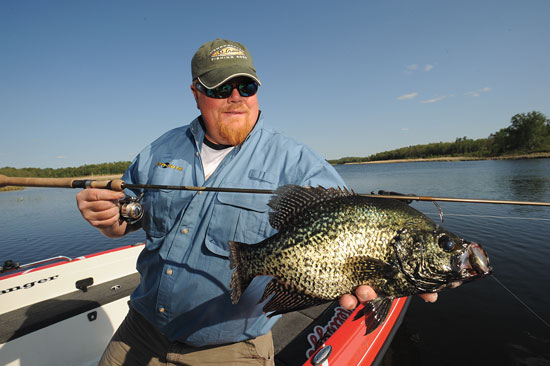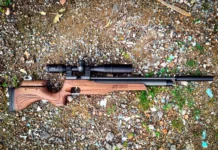
The right panfish rod and reel is a conduit to the underwater world. Anglers often talk about rod tips, as the connection to lure and biting fish. But truly, the tip is no more important than the line, reel, or other aspects of the tool. Trouble is, the difference between a mismatch and a perfect fit can be subtle, even elusive. You can’t always put your finger on it, but when all the pieces — rod, reel, line, lure — fall into place, you know it.
The Dock Shooter
 Some of the biggest sunfish and crappies I’ve caught in recent seasons have been taken by skipping baits below boat docks and other overhanging cover. The rod I use is a 6-foot 6-inch Cabela’s Fish Eagle II (GSII662-2) coupled with a Shimano Sedona 1000FD. The reel’s loaded with 4- or 6-pound braid with an 18-inch fluorocarbon leader.
Some of the biggest sunfish and crappies I’ve caught in recent seasons have been taken by skipping baits below boat docks and other overhanging cover. The rod I use is a 6-foot 6-inch Cabela’s Fish Eagle II (GSII662-2) coupled with a Shimano Sedona 1000FD. The reel’s loaded with 4- or 6-pound braid with an 18-inch fluorocarbon leader.
Its length and soft action match my style of skipping tubes and other softbaits. Other anglers prefer short “shooting” rods coupled with underspin reels, such as the Pflueger Trion Spincast and 6-pound-test mono. The 4-foot 5-inch B’n’M Sharpshooter is a popular option. Anglers grip the back of the lure, loading the rod and pointing the tip toward its target. With a finger on the reel’s trigger, they release lure and trigger simultaneously, shooting the bait well beneath the cover. It’s a method I have yet to master. But watching a shooting specialist, such as Ohio crappie pro Russ Bailey extract slabs from 20 feet back under a pontoon boat, makes a convincing case.
Classic Jig Pitcher
My affection for working diminutive hair jigs and plastics goes back three decades. Even today, it’s hard to outdo a black curlytail grub and 1/32-ounce jig on 2-pound-test mono. In the early years, my favorite rods were a St. Croix Premier (PS66LF) and a Cabela’s Fish Eagle (GS702), models that still sell well.
These 6-foot 6-inch to 7-foot, long-handled, light-power rods enabled me to fling tiny 1/80- to 1/16-ounce jigs for distance. No question that longer — light rather than ultralight — rods cast farther, line and reel being equal. But it’s more than length. The tip section, that is, the final quarter of the blank on the Premier, is soft enough to provide a fast catapult. With a limp 2- or 3-pound-test monofilament coursing through the guides, even a 1/64-ounce jig feels substantial as it hangs from the tip. Done right, a rapid 2-o’clock to 10-o’clock to 2-o’clock pendulum can punch out 30-foot to 50-foot casts, even in moderate headwinds.
It’s tempting to say that softer (slower) tip and butt sections on rods designated ultralight further empower the catapult, resulting in even longer casts. This is true to a point. But excessive softness reduces casting accuracy, jig control, and certainly, sensitivity. Fighting bull bluegills on ultralights is fun, but enticing them to bite is significantly more likely with a precision light-power, moderately fast- to fast-action blank.
Rod tip “action” is described as the speed at which the rod returns to straight after it’s been fully loaded. Moderately soft tips can be fast in action, even though they provide plenty of cushion for catapult casts. There’s a perceivable difference — one’s sloppy, the other precise. A fast yet appropriately soft tip enhances casting distance and provides measured give, yet allows fine control over jigging cadence. The perfect tip allows me to impart petite, precise darts, twitches, and sweeps to a jig without sacrificing the ability to cushion 2-pound mono. Moreover, new feather-light rod guides add another dimension.
Line Advice
Though the labeling on some light-action rods calls for no less than 4-pound line, many of them fish 2- and 3-pound test beautifully. Beyond classic Trilene XL, Maxima’s Ultragreen in 2- and 3-pound test is a workhorse mono that’s been popular for over 40 years. Sunline Siglon F in 2-pound test is another fabulous mono. Ultragreen, however, remains one of the only lines to offer 3-pound test, which remains a versatile choice.
Many anglers have switched from mono to braid, and I can’t fault the choice other than to make a case for stretch. In certain jig scenarios, the stretch of mono has benefits. It prevents premature hook-sets and lip damage that can occur with braid. Stretch prompts fish to hold a bait longer before rejecting it since they don’t feel you pulling back. It provides a shock absorber that keeps fish hooked better as well. In shallow water, mono wins. Deeper than 20 feet, braid rules.
Regarding fluorocarbon, I never spool it on small spinning reels. Its rigidity causes casting problems. It tends to slap the rod blank, and feels heavier on the rod than comparable mono. For abrasion resistance in heavy cover, or as a means of disguise, it’s often beneficial to add a 12- to 18-inch section of 4- to 8-pound-test fluorocarbon at the end of a mono or braid mainline.
Reel Choice
For maximizing casting distance and minimizing line coils, larger spools help. Designations vary somewhat by company, but it’s usually best to select the second smallest spinning reel in a series. Most of my jigging rods are matched with Shimano Stradic CI4 1000s, Pflueger Purist 1325s, or Abu Garcia Cardinal STX10s.
With light mono, smooth reel performance is important, and you mostly get what you pay for. Any rough or “dry” spots in the reel’s rotation can interrupt jig contact, which results in missed bites. Likewise, a smooth drag prevents line breakage.
New Wave Jig Pitcher
New rod options elevate performance on several fronts. One of the sweetest introductions in recent years has been St. Croix’s Panfish Series. I’ve fished several models in this 9-rod series and they all have excellent blank actions. Guide and noted panfish angler Brian Brosdahl is a fan of these rods, choosing the 6-foot 9-inch PFS69ULF and 7-foot PFS70LXF for most of his shallow-water jig casting.
The light power, extra-fast action 7-foot PFS70LXF is a gem. Proprietary St. Croix SCVI graphite provides a fine blend of weight, balance, and sensitivity. Progressive Pac Bay Minima guides cut rod weight significantly and position the rings well away from the blank. This separation reduces line slap, increases casting distance, and seems to enhance sensitivity.
The blank features an appropriately soft casting tip, while the butt section has power for setting hooks and hoisting fish. It couples nicely with a Shimano Stradic CI4 1000F and 3-pound Maxima Ultragreen for casting tiny jigs in shallow water as well as working panfish swimbaits. It fishes instinctively, which is the highest praise I can offer.
The “Bull” Whip
When I first cast the 6-foot 7-inch G. Loomis TSR791 — part of their Trout & Panfish Series — it became another new favorite. Loomis classifies it ultralight power and fast action to handle 2- to 6-pound-test and 1/32- to 3/16-ounce lures. Compared to the St. Croix Panfish option, its blank and tip are slightly faster, and with a bit more beef through the spine.
G. Loomis marketing coordinator John Mazurkiewicz suggested I match it with a Shimano Stradic CI4 1000FML Microline reel, which handles thin polyethylene lines, suchas 3-pound PowerPro Microline, brilliantly. I used that combo to fling 1/16- and 1/8-ounce hair jigs for white bass, trout, perch, and crappies.
Its faster tip was ideal for working jigs slightly more aggressively, and for setting hooks in deeper water, whereas the St. Croix combo worked best in the shallows. I also used that combo to fling crappie-sized cranks. Particularly around cover and in ultra-clear water, I added an 18-inch Sunline Metan Invisible fluoro leader.
Vertical Jigger
Much of the year, we fish vertically for suspended crappies and white bass, as well as bottom-hugging sunfish and perch. Fishing a 1/16- to 1/4-ounce jig, spoon, or a drop-shotrig below the boat are money presentations. For these vertical approaches, a 5-foot rod provides pinpoint control and sensitivity. The tip on my old favorite 5-foot 3-inch Fenwick HMG (GS53L-M) is fast enough to transmit bites in deep water, yet the rest of the blank flexes enough to prevent slack line and lost fish during lengthy fights. Its faster tip can deliver minor quivers and bumps to lures 20 feet below.
Shorter rods keep lures positioned within the sonar’s cone angle. With careful boat control, it’s possible (and often critical) to watch lures and fish reacting to them on the screen.
With low stretch and tiny diameter, 3-pound-test Berkley NanoFil shines for deep vertical approaches. Wide-spool reels such as a Pflueger Purist 1325 minimize line coils and lure spin — critical elements for deepwater jigging.
Spinner Stroller / SlipFloat Dipper
When hunting panfish spread across expanses, slowly trolling with a bow-mount trolling motor is essential. Methods differ north to south, but rod choices don’t. Long 9- to 11-foot rods with extra-soft tips and beefy butt sections excel for towing jigs, cranks, and small spinner rigs adorned with plastics or livebait.
For pulling spinner rigs behind 1/4-ounce bullet sinkers in vegetation, I’ve long used an 11-foot Cabela’s Match Rod, now out of production. Last season, I added an 11-foot St. Croix Panfish Series (PFS110LMF2) rod.
These long, moderately-slow-action rods perform double-duty for slipfloat fishing and for dipping light jigs into tight spots in cover. For trolling, 4- to 10-pound mono or braid works. For slipfloats, it’s 4- to 8-pound mono, depending on cover. In wood, many anglers prefer heavier braid and lightwire hooks to straighten and free snagged rigs with steady pressure.
On recent trips, I’ve been impressed by rods from B’n’M Fishing. Designed by Pickwick Lake, Tennessee, crappie guide Roger Gant, “The Difference” rods (available in 8-, 9-, and 10-foot versions) offer soft, yet sensitive tips on IM6 blanks. Crafted for a crappie tactic known as “side-pulling,” these rods also shine for spider-rigging and for tightlining deep crappies.
When drifting and trolling, multiple long rods go in holders, while anglers monitor their spread until a tip arcs deeply into hooked fish. Small line-holder reels, such as B’n’M’s Buck’s Mini Reel is a popular choice, as are specially designed single-action reels with bait alarms. B’n’M, Bass Pro Shops, and Slater’s offer fine trolling reels.








































